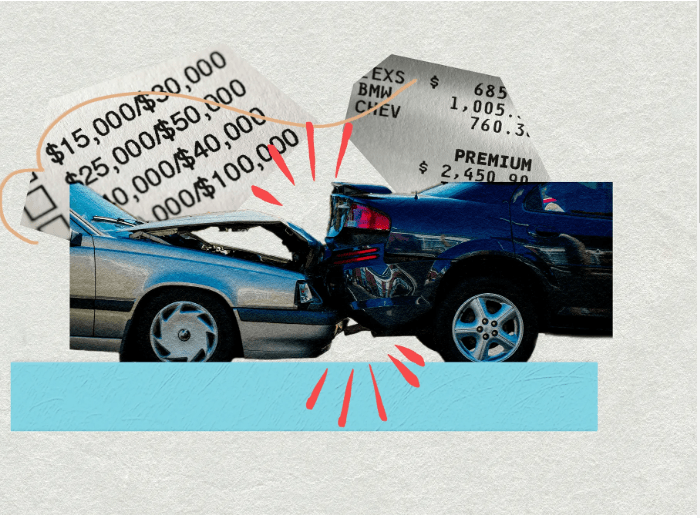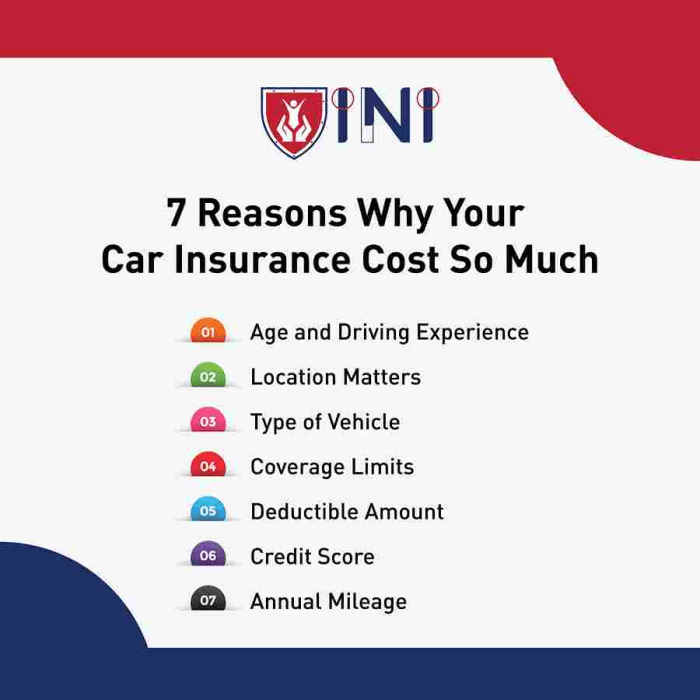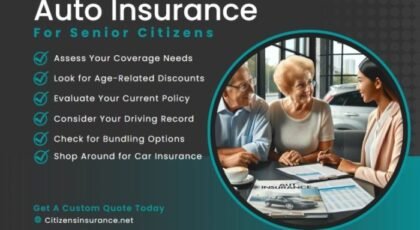Understanding US Car Insurance Costs for New Drivers
Understanding the Costs of Car Insurance for New Drivers in the United States is crucial for young adults gaining independence. The cost of insurance can be a significant financial burden, especially for those just starting out. This guide breaks down the factors that influence premiums, allowing new drivers to make informed decisions and find the best coverage at the most affordable price.
We’ll explore everything from age and driving history to the type of car you drive and even your credit score. Getting a handle on car insurance early on is key to responsible financial management.
Table of Contents
ToggleFactors Influencing Insurance Premiums for New Drivers: Understanding The Costs Of Car Insurance For New Drivers In The United States
Getting your first car insurance policy can feel overwhelming, especially with the wide range of factors affecting the final price. Understanding these factors empowers you to make informed decisions and potentially save money. This section will explore the key elements that insurance companies consider when calculating your premiums.
Age and Car Insurance Costs
Age is a significant factor in determining car insurance rates. Statistically, younger drivers, particularly teenagers and those in their early twenties, are involved in more accidents than older, more experienced drivers. This higher risk translates to higher premiums. Insurance companies use actuarial data to assess risk, and the higher likelihood of accidents associated with inexperience directly impacts the cost.
For example, a 16-year-old new driver will typically pay significantly more than a 25-year-old new driver, even if both have clean driving records. As drivers gain experience and age, their premiums generally decrease.
Driving History and Insurance Premiums
Even without a formal driving history, a lack of experience itself impacts premiums. Insurance companies view new drivers as higher risk due to their inexperience. However, a poor driving record, even minor infractions, will substantially increase premiums. Things like speeding tickets, accidents, or even at-fault collisions significantly increase your risk profile and, therefore, your insurance costs. Conversely, maintaining a clean driving record, even as a new driver, can lead to lower premiums over time.
Car Model and Insurance Costs
The type of car you drive significantly affects your insurance premiums. Insurance companies consider factors such as the car’s safety features, repair costs, and theft risk. Sports cars and luxury vehicles often have higher insurance rates due to their higher repair costs and greater likelihood of theft. Conversely, smaller, more fuel-efficient cars with robust safety features may have lower premiums.
For instance, insuring a new, high-performance sports car will generally be far more expensive than insuring a used, smaller sedan with a good safety rating.
Location and Insurance Rates
Your location, both state and zip code, plays a crucial role in determining your insurance rates. States have varying regulations and laws regarding car insurance, leading to differences in average premiums. Additionally, zip codes reflect the local accident rates and crime statistics within a specific area. Areas with higher accident rates or higher theft rates will typically have higher insurance premiums.
For example, living in a densely populated urban area with a high accident rate will likely result in higher premiums compared to living in a rural area with lower accident statistics.
Types of Car Insurance Coverage and Their Costs

Source: knowherenews.com
Getting car insurance as a new driver can feel overwhelming, especially when faced with different coverage options and their associated costs. Understanding the various types of coverage and their typical price ranges is crucial for making informed decisions and finding a policy that fits your budget and needs. This section will break down the key coverage types and provide a general idea of what you can expect to pay.
Liability Coverage Costs for New Drivers
Liability coverage protects you financially if you cause an accident that injures someone or damages their property. It’s typically broken down into bodily injury liability and property damage liability. Bodily injury liability covers medical bills, lost wages, and pain and suffering for those injured in an accident you caused. Property damage liability covers repairs or replacement of the other person’s vehicle or property.
The cost of liability coverage for new drivers is significantly higher than for experienced drivers due to the perceived higher risk. Factors like your age, driving record (even a clean one for a new driver is still a factor), location, and the type of car you drive all contribute to the final premium. Expect to pay considerably more than the minimum required by your state, which varies widely.
Understanding the Costs of Car Insurance for New Drivers in the United States can be tricky, especially for teens and young adults. High premiums are common, but there are ways to lower your costs. For helpful tips on reducing your insurance expenses, check out this guide: How to Save on Car Insurance for Teens and Young Adults in the U.S.
By following these strategies, you can significantly impact the overall cost of your car insurance as a new driver.
For example, a new driver in a high-risk area might pay $1500-$2500 annually for minimum liability coverage, while a driver in a lower-risk area with a less powerful car could see rates closer to $1000-$1800. These are broad estimates, and actual costs depend heavily on individual circumstances.
Collision and Comprehensive Coverage Costs
Collision coverage pays for repairs or replacement of your vehicle if it’s damaged in an accident, regardless of who is at fault. Comprehensive coverage covers damage to your car caused by events other than collisions, such as theft, vandalism, fire, or hail. These are optional coverages, but often required by lenders if you have a car loan. The cost of collision and comprehensive coverage is also higher for new drivers due to increased risk.
Understanding the Costs of Car Insurance for New Drivers in the United States can be tricky, as premiums are often higher for younger, less experienced drivers. However, finding affordable coverage is possible; check out this guide on How to Find the Most Affordable Car Insurance for Young Drivers in the U.S. to learn some smart strategies. By understanding your options and shopping around, you can significantly reduce your insurance costs and get the coverage you need.
A typical price range for a new driver might be $1000-$2000 annually for both combined, but this can vary significantly depending on the factors mentioned above. For instance, a new driver with a sporty car will pay substantially more than one with an economical sedan. The value of your vehicle also significantly impacts the cost of these coverages.
Uninsured/Underinsured Motorist Coverage Costs
Uninsured/underinsured motorist (UM/UIM) coverage protects you if you’re injured in an accident caused by an uninsured or underinsured driver. It’s crucial because many drivers operate without adequate insurance. The cost of UM/UIM coverage is relatively moderate compared to collision and comprehensive, often adding a few hundred dollars to your annual premium. However, the potential financial protection it offers makes it a worthwhile investment.
The exact cost will vary by state and insurance company but is typically included as part of the overall policy calculation. Many insurers include it at a minimal additional cost to the base liability coverage, reflecting the importance of this protection.
Average Costs of Different Coverage Levels
| Coverage Level | Liability (Annual) | Collision & Comprehensive (Annual) | Total (Annual) |
|---|---|---|---|
| Minimum State Requirements | $1000 – $2500 | $0 | $1000 – $2500 |
| Liability + Collision & Comprehensive | $1000 – $2500 | $1000 – $2000 | $2000 – $4500 |
| Full Coverage (Including UM/UIM) | $1000 – $2500 | $1000 – $2000 | $2200 – $4700 |
Note
These are broad estimates and actual costs will vary significantly based on individual circumstances. It’s crucial to obtain quotes from multiple insurers to compare prices.
Discounts and Ways to Reduce Insurance Costs
So, you’re a new driver facing potentially high insurance premiums. Don’t despair! There are several ways to significantly lower your costs. Insurance companies offer a range of discounts, and smart choices regarding your policy can make a big difference. Let’s explore some effective strategies.Many insurers understand that new drivers are a higher risk, but they also want to reward responsible behavior and encourage safe driving habits.
Understanding car insurance costs for new drivers in the US can be tricky, as premiums are significantly higher than for experienced drivers. A major factor influencing these costs is location, as rates differ wildly across the country. For a detailed look at these regional differences, check out this helpful resource: How Car Insurance Rates Vary by State: A Breakdown for American Drivers.
Knowing how state-specific regulations and risk profiles impact pricing is key to finding affordable coverage as a new driver.
This leads to a variety of discounts designed to make insurance more affordable. By taking advantage of these options and making informed decisions about your coverage, you can keep your premiums manageable.
Discounts Offered to New Drivers
Several discounts are commonly available to new drivers. These can significantly reduce your overall insurance costs. Securing these discounts often involves providing proof or documentation to your insurer.
- Good Student Discount: Maintaining a high GPA (typically a B average or better) often qualifies you for a discount. This reflects the insurer’s assessment that academically successful individuals tend to be more responsible and cautious.
- Safe Driver Discount: Some insurers offer discounts for completing a defensive driving course or maintaining a clean driving record for a specified period. This demonstrates your commitment to safe driving practices.
- Telematics Programs: These programs use a device or app to track your driving habits. Safe driving behavior, such as avoiding speeding and harsh braking, can earn you discounts. The data collected helps insurers assess your risk more accurately.
- Bundling Discounts: Combining your car insurance with other types of insurance, such as homeowners or renters insurance, from the same company often results in a discount. This is a simple way to save money.
- Vehicle Safety Features Discount: Cars equipped with advanced safety features, such as anti-lock brakes, airbags, and electronic stability control, may qualify for discounts. Insurers recognize these features reduce the likelihood of accidents.
Strategies for Obtaining Lower Premiums
Beyond discounts, strategic choices can further reduce your insurance costs.Choosing a higher deductible, while initially seeming counterintuitive, can significantly lower your premiums. A higher deductible means you pay more out-of-pocket in the event of an accident, but the trade-off is a lower monthly payment. For example, a $1000 deductible might result in lower premiums compared to a $500 deductible.
Carefully weigh the potential cost of a higher deductible against the savings on your premiums to find the balance that suits your financial situation.
Understanding car insurance costs for new drivers in the US can be tricky, especially with high premiums. However, the cost considerations change as your car ages; check out this article on Why You Should Consider Comprehensive Car Insurance for Older Cars in the U.S. to understand different coverage needs. Ultimately, finding the right balance between coverage and cost is key for both new and experienced drivers.
Impact of Choosing a Higher Deductible
The deductible is the amount you pay out-of-pocket before your insurance coverage kicks in. A higher deductible means lower premiums because you’re accepting more financial risk. For instance, if you choose a $1000 deductible and have a $2000 accident, you would pay $1000, and your insurance would cover the remaining $1000. However, if you opt for a $500 deductible, your premiums would be higher, but your out-of-pocket expense in the same scenario would only be $500.
It’s crucial to carefully consider your financial capacity to handle a higher deductible before making this decision.
The Role of Credit Score in Insurance Rates
Many people are surprised to learn that their credit history plays a significant role in determining their car insurance premiums. Insurance companies use credit-based insurance scores (CBIS) to assess risk, believing that individuals with poor credit are more likely to file claims. This isn’t about your driving record; it’s about your overall financial responsibility as perceived by the insurer.Credit history affects car insurance premiums for new drivers in a substantial way.
Insurers view a low credit score as an indicator of higher risk, leading to significantly higher premiums. Conversely, a good credit score can result in lower premiums, potentially saving new drivers a considerable amount of money. The reasoning behind this practice is that individuals with a history of responsible financial management are statistically less likely to make late payments on their insurance or be involved in accidents that lead to claims.
Credit Score Impact on Insurance Costs
The difference in insurance costs between individuals with good and poor credit scores can be dramatic. For example, a new driver with a poor credit score might pay hundreds, even thousands, more annually than a new driver with an excellent credit score, even if they have identical driving records and choose the same coverage. A hypothetical example: Two 18-year-old drivers in the same city, driving the same car, and selecting identical coverage might see a difference of $500-$1000 or more per year based solely on their credit scores.
This disparity highlights the importance of maintaining a good credit history. The specific cost difference will vary depending on the insurer, the state, and other factors, but the trend remains consistent: better credit generally translates to lower insurance premiums.
Improving Credit Score to Lower Insurance Costs
New drivers can take several steps to improve their credit score and subsequently lower their car insurance costs. Building a strong credit history takes time and consistent effort, but the long-term rewards, including lower insurance premiums, are significant.Improving your credit score involves several key strategies. First, pay all bills on time, every time. Late payments significantly harm your credit score.
Second, keep your credit utilization low. This means keeping your credit card balances as low as possible compared to your total credit limit. Aim for less than 30% utilization. Third, maintain a diverse credit mix. Having a mix of credit accounts, such as credit cards and loans, can positively impact your score.
Fourth, avoid opening too many new credit accounts in a short period. Fifth, check your credit report regularly for errors and inaccuracies. Dispute any errors you find with the credit bureaus. By diligently following these steps, new drivers can significantly improve their credit scores and potentially save a considerable amount on their car insurance premiums over time.
Comparison of Insurance Companies and Their Rates
Shopping for car insurance can feel overwhelming, especially as a new driver. Many companies offer policies, and their rates can vary significantly. Understanding how these rates compare is crucial for finding the best deal. This section will explore how different insurance providers price their policies and offer resources to help you compare them effectively.
Several factors contribute to the differences in rates between insurance companies. These include the company’s risk assessment models, their claims handling processes, the specific coverage options they offer, and the overall profitability of their business model. Some companies may focus on attracting lower-risk drivers, leading to lower premiums for those who qualify. Others might offer more comprehensive coverage but at a higher price point.
It’s essential to compare apples to apples – ensuring you’re looking at similar coverage levels when comparing quotes from different insurers.
Average Premiums of Major Insurance Providers
The following table presents a simplified comparison of average annual premiums for new drivers in the United States. Remember that these are averages and your actual rate will depend on many individual factors, including your driving record, location, vehicle, and the specific coverage you choose. These figures are illustrative and should not be considered definitive quotes. Always obtain personalized quotes directly from the insurance companies.
| Insurance Company | Average Annual Premium (Estimate) | Notes |
|---|---|---|
| Progressive | $1800 | Known for its online tools and discounts. |
| State Farm | $1750 | A large, established company with a wide range of options. |
| Geico | $1600 | Often advertised for its competitive rates. |
| Allstate | $1900 | Offers various bundles and additional services. |
Using Online Comparison Tools
Online comparison tools are invaluable for streamlining the process of comparing car insurance rates. These websites allow you to enter your information once and receive quotes from multiple insurers simultaneously. This saves significant time and effort. However, it’s crucial to be aware of the limitations. While these tools provide a good starting point, they might not always show every available option or discount.
Always verify the details directly with the insurer before making a final decision.
Many reputable comparison websites exist, and their features vary. Some offer more detailed comparisons, while others focus on simplicity. Consider factors such as the number of insurers included, the range of coverage options displayed, and the user-friendliness of the interface when choosing a comparison tool. Reading reviews from other users can also help guide your selection. After using a comparison tool, it’s highly recommended to contact the insurance companies directly to discuss your options and confirm the quotes you’ve received online.
This step ensures accuracy and allows you to ask any clarifying questions.
Understanding Insurance Policies and Fine Print
Navigating the world of car insurance policies can feel overwhelming, especially for new drivers. Understanding the terms and conditions, the claims process, and your rights as a policyholder are crucial for protecting yourself financially. This section clarifies common policy elements and provides guidance for a smoother experience.
Common Terms and Conditions in Car Insurance Policies, Understanding the Costs of Car Insurance for New Drivers in the United States
Insurance policies contain a variety of terms that can be confusing. Familiarizing yourself with key definitions will help you understand your coverage and responsibilities. For example, “deductible” refers to the amount you pay out-of-pocket before your insurance coverage kicks in. “Premium” is the regular payment you make to maintain your insurance coverage. “Liability coverage” protects you financially if you cause an accident that injures someone or damages their property.
“Collision coverage” covers damage to your vehicle in an accident, regardless of fault. “Comprehensive coverage” protects your vehicle against non-collision damage, such as theft or vandalism. Understanding these basic terms is the first step in interpreting your policy. Policies also often include clauses about exclusions, which specify situations where coverage won’t apply, such as driving under the influence of alcohol or drugs.
The Claim Filing Process and Associated Costs
Filing a claim usually involves contacting your insurance company immediately after an accident. You’ll typically need to provide details about the accident, including the date, time, location, and parties involved. You might also need to provide police reports, photos of the damage, and medical records if injuries occurred. The insurance company will investigate the claim, and depending on the type of coverage and the specifics of the accident, you may have to pay your deductible before receiving reimbursement for repairs or medical expenses.
There may also be administrative fees or other associated costs, depending on your policy and the circumstances. For example, if your car is totaled, the insurance company will determine its actual cash value (ACV) and pay you that amount, minus your deductible. If your claim is denied, you have the right to appeal the decision.
Tips for Understanding and Negotiating Insurance Policy Details
Before signing any insurance policy, carefully read the entire document, paying close attention to the fine print. Don’t hesitate to ask your insurance agent to clarify anything you don’t understand. Compare quotes from multiple insurance companies to find the best coverage at the most competitive price. Consider bundling your car insurance with other types of insurance, such as homeowners or renters insurance, to potentially save money.
Take advantage of discounts whenever possible, such as those for good driving records, safety features in your car, or completing a defensive driving course. Keep accurate records of your policy documents, claims, and communications with your insurance company. Remember, you have the right to negotiate certain aspects of your policy, such as your deductible or coverage limits, to find a balance that meets your needs and budget.
For instance, a higher deductible will typically result in lower premiums.
The Impact of Driving Habits on Insurance Costs
Your driving habits significantly impact your car insurance premiums. Insurance companies assess risk, and a history of safe driving translates to lower costs, while risky behavior leads to higher premiums. This is because statistically, drivers with certain habits are more likely to be involved in accidents or receive traffic violations, resulting in higher payouts for insurance companies.Insurance companies use a variety of factors to assess your driving habits.
These include your driving record, which details accidents, speeding tickets, and other moving violations. The more incidents you have, the higher your risk profile, and consequently, your insurance premiums. Even seemingly minor infractions can add up over time, leading to substantial increases in your rates. For example, multiple speeding tickets in a short period could increase your premium by 20-30% or more, depending on the severity of the violations and your insurance provider.
A single at-fault accident could lead to an even larger increase.
Understanding car insurance costs as a new driver in the US can be tricky. A big factor is choosing the right coverage; to understand the difference between options, check out this helpful guide: What’s the Difference Between Full Coverage and Liability Insurance in the U.S.? Knowing this will help you budget effectively and choose the policy that best suits your needs and financial situation.
Driving Record and its Influence on Premiums
A clean driving record is the cornerstone of lower insurance premiums. Each incident – be it a speeding ticket, a collision, or a DUI – is carefully weighed by insurance companies. The severity of the incident also matters. A minor fender bender will typically result in a smaller premium increase compared to a serious accident causing significant damage or injury.
Insurance companies often use a points system, assigning points to each violation. The accumulation of points directly correlates to higher premiums. For instance, a DUI conviction will typically result in a much higher number of points than a simple speeding ticket, leading to a substantial increase in insurance costs. Furthermore, the length of time since the incident also plays a role; older violations generally have less weight than more recent ones.
Telematics Devices and Usage-Based Insurance
Many insurance companies now offer usage-based insurance (UBI) programs, often utilizing telematics devices. These devices, which can be plugged into your car’s diagnostic port or integrated into a smartphone app, track various aspects of your driving, such as speed, acceleration, braking, mileage, and driving times. The data collected is then used to assess your driving behavior. Safe driving habits, as measured by the telematics device, can lead to significant discounts on your premiums.
Conversely, risky driving behavior, such as frequent hard braking or speeding, may result in higher premiums. For example, a driver who consistently maintains safe speeds and avoids aggressive driving could receive a discount of 10-30% or more on their premium through a UBI program. This personalized approach to insurance pricing incentivizes safer driving habits and can lead to substantial savings for responsible drivers.
It’s important to note that the specific discounts and penalties vary depending on the insurance company and the specific telematics program.
Financial Planning for Car Insurance as a New Driver
Securing your first car is an exciting milestone, but the responsibility of car insurance can feel overwhelming, especially with the higher premiums new drivers face. Effective financial planning is crucial to avoid unexpected financial strain and ensure you can maintain adequate coverage. This section will Artikel strategies for budgeting and managing your car insurance expenses.Budgeting for car insurance requires careful consideration of various factors.
Your initial premium will be a significant expense, but remember that this is just the starting point. Your rates can fluctuate based on factors like driving record, claims, and even changes in your credit score. It’s essential to build a buffer into your budget to account for these potential increases.
Creating a Realistic Car Insurance Budget
Building a car insurance budget begins with obtaining quotes from multiple insurers. Compare premiums based on the coverage you need and your personal circumstances. Once you have a realistic estimate of your monthly or annual premium, integrate this expense into your overall monthly budget. Treat your car insurance payment like any other essential bill, such as rent or utilities.
Consider setting up automatic payments to avoid late fees and ensure consistent coverage. It’s also wise to allocate a separate savings account specifically for car insurance, allowing you to accumulate funds for unexpected costs or premium increases. For example, if your monthly premium is $150, you might budget $175 to accommodate potential fluctuations. This extra $25 per month could cover unexpected increases or even a small claim without disrupting your overall finances.
Managing Unexpected Insurance Costs
Unexpected expenses, such as accidents or traffic violations, can significantly impact your car insurance premiums. To mitigate the financial burden of these unexpected costs, creating an emergency fund specifically for car-related expenses is vital. This fund should ideally cover at least three to six months of your car insurance premiums. Furthermore, consider purchasing supplemental insurance, like gap insurance, which protects you from potential financial losses if your car is totaled and your insurance payout is less than the loan amount.
For instance, if you’re financing a car and are involved in an accident, gap insurance can cover the difference between the insurance payout and the remaining loan balance.
Utilizing Discounts and Savings Opportunities
Many insurance companies offer discounts that can reduce your premiums. These discounts can range from bundling your car and homeowners insurance to completing a defensive driving course. Actively researching and taking advantage of these discounts can significantly reduce your overall insurance costs. For example, a good student discount could lower your premium by 10-20%, while a multi-car discount from insuring multiple vehicles under the same policy could provide even greater savings.
Regularly reviewing your policy and exploring available discounts can ensure you are getting the best possible rate.
Resources for New Drivers Seeking Car Insurance
Finding affordable car insurance as a new driver can feel overwhelming, but several resources are available to guide you through the process. These resources can help you understand your options, compare prices, and ultimately secure the best coverage for your needs and budget. Utilizing these tools can save you both time and money.Finding the right car insurance can be a challenge, especially for new drivers.
Fortunately, there are numerous resources available to help navigate this process. These range from independent comparison websites to state-specific insurance departments and consumer advocacy groups. By leveraging these resources, new drivers can make informed decisions and potentially save money on their premiums.
Independent Insurance Comparison Websites
Many websites specialize in comparing car insurance quotes from multiple providers. These sites typically require you to input your information (age, driving history, car details, etc.) once, and then they present quotes from various insurers. This allows for easy side-by-side comparison of prices and coverage options. Remember to check the reputation and trustworthiness of these websites before providing personal information.
Some popular examples include NerdWallet, The Zebra, and Insurify. These sites often offer additional resources and articles on car insurance topics, making them valuable tools for new drivers.
State Insurance Departments
Each state has a department of insurance that regulates insurance companies operating within its borders. These departments often provide valuable resources for consumers, including information on how to file complaints, find licensed insurers, and understand their rights. Their websites typically offer educational materials on car insurance, explaining different coverage types and helping consumers avoid scams. Checking your state’s insurance department website is a crucial first step in your car insurance search.
Consumer Advocacy Groups
Organizations like the National Association of Insurance Commissioners (NAIC) and the Consumer Federation of America (CFA) offer resources and information on various insurance-related topics. They often provide guidance on how to choose the right insurance, file complaints, and advocate for consumer rights. These groups can be invaluable in helping you understand the complexities of car insurance and ensure you are treated fairly.
Their websites often contain articles, reports, and guides that are specifically designed to help consumers navigate the insurance market.
Financial Education Websites and Organizations
Many reputable financial education websites and organizations offer information on car insurance as part of their broader financial literacy programs. These resources often provide advice on budgeting for insurance costs, understanding different coverage options, and managing your insurance expenses effectively. Looking for advice on personal finance generally can often lead you to useful information on car insurance.
Legal Aspects of Car Insurance for New Drivers
Navigating the legal landscape of car insurance as a new driver can be confusing, but understanding the requirements and consequences is crucial for safe and responsible driving. Failure to comply with state laws can lead to significant penalties, impacting your driving privileges and finances. This section clarifies the legal requirements for car insurance across the United States and the potential repercussions of non-compliance.State Minimum Insurance Requirements Vary Significantly.
Each state mandates a minimum level of car insurance coverage, and these requirements differ considerably. Some states require only liability coverage, protecting others from your potential negligence, while others mandate additional coverage like uninsured/underinsured motorist protection. These minimums are often insufficient to cover significant accident-related costs. For example, a state might require only $10,000 in bodily injury liability coverage per person, which could quickly prove inadequate in a serious accident.
New drivers should research their specific state’s requirements to ensure they meet the legal minimum and consider purchasing higher coverage limits for greater protection.
State-Specific Minimum Insurance Requirements
The minimum insurance requirements vary widely from state to state. For instance, some states may have a minimum liability coverage of $25,000 per person and $50,000 per accident, while others may have much higher or lower limits. Some states also require Uninsured/Underinsured Motorist (UM/UIM) coverage, protecting drivers in accidents caused by uninsured or underinsured drivers. It is imperative for new drivers to check their state’s Department of Motor Vehicles (DMV) website or consult an insurance professional to determine the exact legal minimums.
Failing to do so can lead to serious financial and legal consequences.
Consequences of Driving Without Insurance
Driving without the legally required insurance carries severe penalties. These consequences vary by state but typically include fines, license suspension, and even jail time. Beyond legal ramifications, driving without insurance leaves you financially vulnerable in the event of an accident. If you cause an accident, you would be personally responsible for all damages, potentially leading to significant debt or bankruptcy.
Moreover, your ability to obtain insurance in the future may be affected, resulting in higher premiums or difficulty securing coverage. In some states, driving without insurance is considered a misdemeanor, while in others it may be a felony depending on the circumstances. The severity of the penalties increases with repeat offenses.
Illustrating the Cost Differences with Visual Aids

Source: indemnitynationalinsurance.com
Visual representations are crucial for understanding the complexities of car insurance costs for new drivers. A clear chart can effectively communicate the significant price variations based on factors like age and driving experience. This section will describe a chart illustrating average insurance premiums for different age groups of new drivers.
The chart would be a bar graph, with the horizontal axis representing the age of the new driver (in years), ranging from 16 to 25. The vertical axis would represent the average annual cost of car insurance premiums, expressed in US dollars. Each bar would represent a specific age group, and its height would correspond to the average insurance cost for that age group.
Data points would be clearly labeled above each bar.
Average Car Insurance Costs by Age Group for New Drivers
For example, the chart might show that the average annual premium for a 16-year-old new driver is significantly higher than that of a 25-year-old new driver. This reflects the higher risk associated with younger, less experienced drivers. Specific data points could be as follows (these are illustrative examples and may vary depending on location and insurer):
| Age | Average Annual Premium (USD) |
|---|---|
| 16 | $2500 |
| 17 | $2200 |
| 18 | $2000 |
| 19 | $1800 |
| 20 | $1600 |
| 21 | $1400 |
| 22 | $1300 |
| 23 | $1200 |
| 24 | $1100 |
| 25 | $1000 |
The chart would clearly demonstrate the substantial decrease in average insurance premiums as the new driver ages and gains more driving experience. This visual representation would make it easier for new drivers to understand the financial implications of their age and driving history on their car insurance costs. The difference between the highest and lowest premiums would be visually striking, highlighting the significant cost savings associated with gaining experience.
Epilogue
Navigating the world of car insurance as a new driver can feel overwhelming, but understanding the key factors influencing your premiums empowers you to make smart choices. By comparing quotes, taking advantage of discounts, and practicing safe driving habits, you can significantly reduce your costs. Remember, responsible driving and financial planning go hand-in-hand, setting you up for success on and off the road.
So, shop around, drive safely, and enjoy the open road!
FAQ Guide
How long does my insurance rate stay high as a new driver?
Typically, your rates will gradually decrease as you gain more driving experience and a clean driving record. This usually takes a few years.
Can I get car insurance without a driver’s license?
No, you generally need a valid driver’s license to obtain car insurance.
What if I’m a student? Are there any special discounts?
Yes, many insurers offer good student discounts for maintaining a certain GPA. Ask your insurer about this.
What’s the difference between liability and full coverage?
Liability covers damages you cause to others. Full coverage adds collision (damage to your car) and comprehensive (other damage like theft or weather). Full coverage is typically more expensive.



